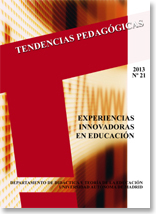PROOF OF PISA 2009 THE READING COMPETITION A DIDACTIC EXPLANATION ON THE POSSIBLE CAUSES OF THE LOW LEVEL OF PERFORMANCE OF MEXICAN STUDENTS IN LA SUBESCALA OF INTEGRATING AND INTERPRETING
Keywords:
Reading literacy, integrating, interpreting, understanding, reasoning.Copyright (c) 2015 Tendencias Pedagógicas

This work is licensed under a Creative Commons Attribution-NonCommercial 4.0 International License.
Abstract
This article is about of results of Mexican students in PISA 2009, in the area of Reading, in the subscale integrate and interpret information. Since were located 44% in the low levels (Below Level 1b, Level 1b and Level 1a), the purpose is to gauge the pedagogical problem. So, I think that the students did not respond consistently to the series of reagents of these levels, because they applied cognitive approach method of lesser extent and the criteria used to determine the validity of their epistemic conjectures, not allowed to establish what is the overall coherence unit from the characteristics shown by the stimulus.Downloads
References
Beaton, A. Item sampling, en Keeves, J. (1997). Educational research, methodology, and measurement: An international handbook (2nd.ed.). Cambridge: Pergamon. pp. 976-984.
Biggs, B. y Collis, F. (1982). Evaluating the Quality of Learning: The SOLO taxonomy. Nueva York: Academic Press.
Carrasco, A. (2003). La escuela puede enseñar estrategias de lectura y promover su regular empleo, Revista Mexicana de Investigación Educativa, 8, (17)
-142.
Colleman, J. et al. (1966). The quality of educational opportunity. Washinton: U.S. Goverment printing office.
Cunningham, A. E. y K. E. Stanovich (1998). Early Reading acquisition and its relation to Reading experience and ability 10 years later, Developmental
psychology, vol 33, pp. 934-945.
Flavell, J.H. (1993). El desarrollo cognitivo. Madrid. Aprendizaje Visor.
IE (2010). La Lectura en PISA 2009. Marcos y Pruebas de Evaluación. Madrid: Omagraf S.L.
INEE (2010). México en PISA 2009. México: IEPSA
INEE (2011). Base de datos PISA 2009. Base School_mex_SPSS_PISA09.zip y Cog_mex_SPSS_S_PISA09.zip Tomadas el día 3 de septiembre de 2012, desde http://www.inee.edu.mx/index.php/bases-de-datos/bases-de-datospisa/bases-de-datos-pisa-2009
Kintsch, W.(1998). Comprehension: A paradigm for cognition. Cambridge, MA: Cambridge University Press.
Kirsch, I. (2001). The International Adult Literacy Survey: Understanding What Was Measured, Educational Testing Service, Princeton, NJ.
Latapí, P. et al. (2006). Los retos de México en el futuro de la educación. Conejo de especialistas para Bibliografía. México: SEP.
Leu D. y Kinzer Ch. (1987) Effective reading instruction in the elementary grades. Columbus: Merrill Pub. Co.
Martínez, R. (2006). La metodología de los estudios de PISA. Revista educación. Número extraordinario 2006. España. pp. 111-129.
Messner, R. (2009). PISA y la formación general. Profesorado. Revista de currículum y Formación de Profesorado. Agosto. Vol. 13, Núm. 2. pp. 1-12
OCDE (2000). La medida de los conocimientos y destrezas de los alumnos. Un nuevo marco de medición. Madrid: INCE. Tomado el día 8 de octubre de 2012 desde
OCDE (2009). PISA 2009 Assessment Framework Key competencies in Reading, Mathematics and Science. Tomado el día 28 de agosto de 2012 desde
http://www.oecd.org/pisa/pisaproducts/44455820.pdf
OCDE-GIP (2009). Iberoamérica en PISA 2009. Informe regional. Madrid: Santillana
OCDE (2010a), PISA 2009 Resultados: Lo que los estudiantes saben y pueden hacer. Rendimiento de los estudiantes en Lectura, Matemáticas y Ciencias
(Volumen I). España: Santillana.
OCDE (2010b). PISA 2009 Results: Learning engagement, strategies and practices (Volume III) Tomado el día 34 agosto de 2012 desde
http://www.oecd.org/pisa/pisaproducts/48852630.pdf
Olson, D. y Torrance N. (2001) Conceptualizing Literacy as a personal skill and as a social practice, en The making of literate societies. Massachussets: Blackwell Publisher.
Pearson,D.; Roehler, R.; Dole, A. y Duffy, A. (1992). Developing expertise in reading comprehension, en S. Samuels y A. Farstrup (Eds.), What research has to say about reading instruction, 2da ed, Newark, DE: IRA,
pp. 145-199.
Pressley, M. (2002). Metacognition and self-regulated comprehension, en A.E. Farstrup y S. Samuels (Eds.), What Research Has to Say About Reading Instruction, Newark, DE: International Reading Association, pp. 291-309.
Pintrich, R. (2002). Future challenges and directions fortheory and research on personal epistemology. En Hofer, B. K.& Pintrich, R. (eds.), Personal Epistemology: The Psychology of Beliefs About Knowledge and Knowing, Erlbaum,Mahwah, NJ.
Ryan, P. (1984). Monotoring text comprehension: individual differences in epistemological standards. Journal of Educational Psychology,76, 248-258.
Shaffer, D. (2000). Psicología del desarrollo. Infancia y adolescencia. 5ª.ed. Madrid: International Tomson Editores
SEP (2006). Reforma de la Educación Secundaria. Fundamentación Curricular. Español. México: SEP. Tomado el día 18 de septiembre de 2012, desde
http://www.reformasecundaria.sep.gob.mx/doc/FUNDAMENTACIONES/espanol.pdf
SEP (2011) Plan y programa de Secundaria en Español. México: SEP tomado el día 1 septiembre de 2012 desde
http://basica.sep.gob.mx/reformasecundaria/
SEP (2012). Estándares Nacionales de Habilidad Lectora. Tomado el día 31 de octubre de 2012 desde http://www.leer.sep.gob.mx/index.html
Solé, I. (2006). Estrategias de lectura. 16a ed. Barcelona: Graó
Smith, M. et al (2000) What will be the demands of literacy in the workplace in the next millennium. Reading Reaserch Quarterly, 35(3), pp. 378-383.
Saussure, F. (1977). Curso de Lingüística General. Buenos Aires: Lozada.
Wittgenstein, L. (1988). Investigaciones filosóficas. Barcelona: Crítica
